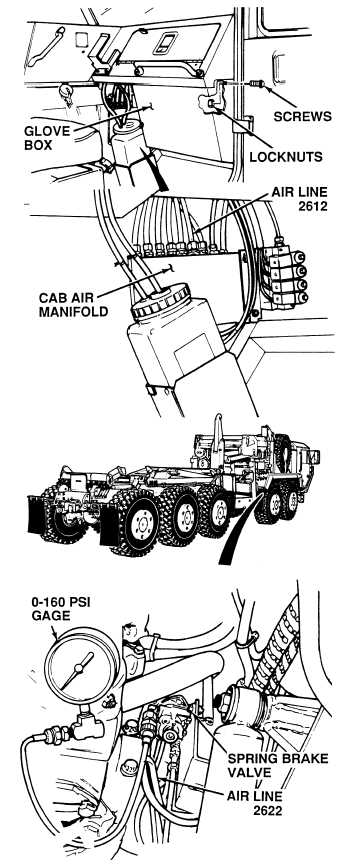|
| |
TM 9-2320-364-20-2
2-1775
(1) Start engine and build pressure
to 125 4 psi (861 28 kPa)
(TM 9 2320-364-10).
(2) Turn OFF ENGINE switch.
(3) Remove six screws, locknuts and
glove box. Discard locknuts.
(4) Loosen air line 2612 on cab air
manifold enough to allow air to leak
from fitting, while assistant observes
AIR PRESS gage.
(a) If there is a constant flow of air
and a drop in AIR PRESS, replace
dash manifold valve (Para 12-37).
(b) If there is a small amount of air
flow and no drop in AIR PRESS,
dash manifold valve is OK.
(5) Tighten air line on cab air manifold.
(6) Install glove box, six screws and
locknuts.
(1) Disconnect air line 2622 from spring
brake valve.
(2) Connect a 0 to 160 psi (0 to 1103 kPa)
gage to spring brake valve outlet.
(3) Release PARKING BRAKE
(TM 9-2320-364-10).
(a) If there are 125 4 psi
(861 28 kPa) present at outlet of
spring brake valve, perform Steps
(4) and (5) below and replace
spring brake valve (Para 12-18).
(b) If there are not 125 4 psi
(861 28 kPa) present at air line
2622, spring brake valve is OK.
(4) Apply PARKING BRAKE.
(5) Remove pressure gage and connect
air line 2622 to spring brake valve.
Wear safety goggles when performing leakage
tests on valves. Failure to do so may
result in serious eye injury due to high
pressure air.
Truck must be on level ground and wheels
must be chocked before parking brake is
released. Otherwise, truck may roll and
cause injury to personnel.
DASH MANIFOLD VALVE TEST
SPRING BRAKE VALVE TEST
|

